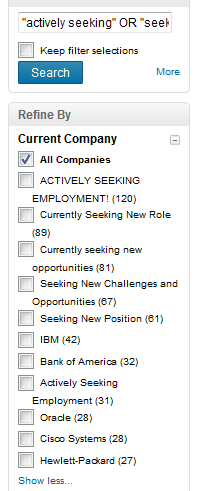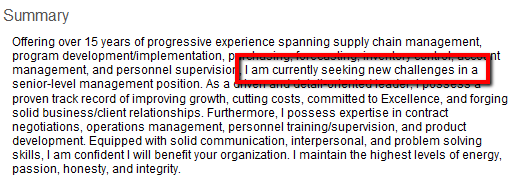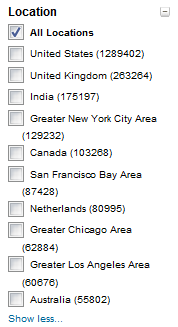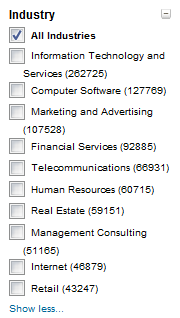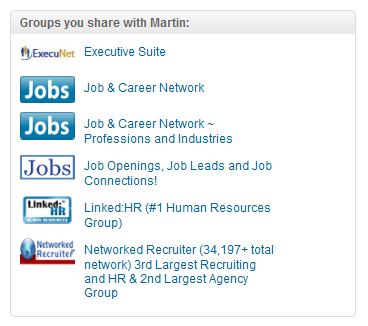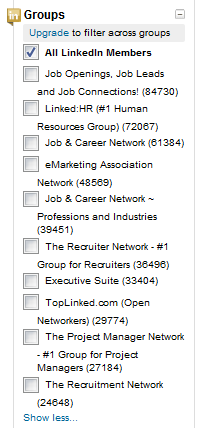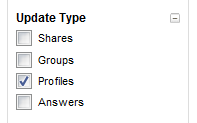 I’ve received a few inquiries over the past month regarding how to find active job seekers on LinkedIn.
I’ve received a few inquiries over the past month regarding how to find active job seekers on LinkedIn.
This isn’t something I do, nor have I ever tried to do it, so I didn’t have any read-made search suggestions for these folks.
I don’t recruit people because they are looking to make a move – I recruit people based on their skills, experience and critical intangibles. I could care less if they are looking or if the thought of leaving their current employer is the furthest thing from their mind.
In my opinion and experience, everyone is a candidate and anyone can be recruited if you have a great match between their skills, experience and interests and the opportunity you’re looking to fill.
Having said all that, if you want to search LinkedIn to identify people who are highly likely to be actively seeking employment, you have a few options.
How to Find Active Job Seekers on LinkedIn
As with nearly all human capital information retrieval efforts, experimentation and pattern recognition are key.
When it comes to finding people who are likely to be active job seekers, the first thing you can do is think about what types of words and phrases these people might use on their LinkedIn profiles to signify that they are looking for a new opportunity.
I don’t want to risk losing anyone with this comparison, but I think it’s critical that you realize that any solid sourcing methodology employs the scientific method for acquiring new knowledge, or correcting and integrating previous knowledge. The foundation of the scientific method is to propose a hypothesis and to design experimental efforts to test the hypothesis via predictions which can be derived from them.
Let’s hypothesize that people on LinkedIn who are looking for new employment would actually state such on their profile, and let’s predict that they might write such things as “currently seeking,” or “seeking new.”
We can test this hypothesis by running the search to see if we get any results, and if we do, how many results are returned.
When I ran the search, I got 36,222 results for all of LinkedIn (all locations).
That struck me as low, but at least we have verified that some people do in fact mention that they are actively seeking new employment on their LinkedIn profile.
Now we need to continue to hypothesize as to other phrases people might use to denote that they are looking for employment.
Before we do, however, let’s take notice of some information returned from that first search.
Looking over at the “Current Company” facet, we hit a little jackpot of information in the form of people actually entering in active job seeker phrases in their current employer field.
One thing you can glean from this section is 2 new job seeking phrases to search for – “actively seeking” and “seeking employment.”
Another thing to notice is the companies that are in the top 10 list.
Getting back to the “actively seeking” OR “seeking new” search results, you will see that this first very basic and limited search works…
…but it also pulls false positives in the form of people who mention “seeking new” in ways not referring to employment opportunities.
When it comes to information retrieval, false positives are inevitable – the goal is to minimize them whenever possible.
LinkedIn Search String to Find Active Job Seekers
After spending about 10 minutes reviewing results, iteratively modifying my searches and looking for patterns of phrasing for seeking employment as well as hypothesizing (making educated guesses) what people might say to signify that they are pursuing employment, here is what I came up with:
That search returns 2.43M people globally – quite an improvement over 36K!
You probably noticed I decided to search for “seeking” without searching for specific “_______ seeking” or “seeking ______” phrases.
That’s because searching for “seeking” is actually more effective than using it in specific phrases.
Searching for the single term “seeking” is a double edged sword – it pulls false positives because it isn’t an intrinsically specific term for pursuing employment, but if you decide to add terms to it to create specific phrases, you will actually eliminate viable results of people who are looking for a new job.
This is because there are literally 100’s of ways people can specify what they are looking for in their job search.
For example:
Because of this, I would recommend simply searching for the term “seeking” and accept a percentage of false positives because there is no way you can think of (or search for) every possible combination of “seeking _______” that someone might use to denote what kind of role they are seeking.
If you are a recruiter and you are not looking for other recruiters, you may want to add something like -(recruiter OR recruitment) to your string/query to eliminate false positives of recruiters that mention they are seeking/looking for people with specific titles and skill terms.
Of course, you can also use all of the above approaches when X-Ray searching LinkedIn through Google or another search engine, although I personally recommend starting with and exhausting LinkedIn’s search before searching LinkedIn via an Internet search engine.
LinkedIn Offers Great Job Seeker Intel!
I can’t move on before sharing one of my favorite features of LinkedIn – the ability to see the top 10 results by current company, location, industry, etc.
I find this information fascinating – and when you run your own searches by your country or metro area, you’ll get even more applicable insight.
Here are the top 10 results by location, current company, and industry for the 12 active job seeker term search:
When searching globally, it’s not surprising to see some of the largest employers in the top 10, but there are some very large employers that are not listed and a few companies in the top 10 that I didn’t expect to see there.
Here’s the global top 10 industry breakdown:
LinkedIn Jobs and Recruiting Groups
When reviewing your results, other patterns you can notice are things such as the groups that the people who mention they are actively pursuing employment belong to.
You can notice this in a couple of places, including the “Groups you share with ______”
…and the groups facet which can be expanded to show the top 10 groups:
If a medical device development project manager is in several job and recruiting-focused groups, it might be a sign that (s)he is trying to connect with recruiters in an attempt to find new employment. Hello!
Bullhorn Reach Radar
Some people have hypothesized that making numerous changes to a LinkedIn profile and/or adding multiple recommendations in a short period of time can be indicative of someone that is beginning to look for new employment.
It’s not a bad theory – but how can you be alerted when people make changes to their LinkedIn profile and rack up recommendations?
One way is to use Bullhorn Reach’s Radar.
Radar isolates key LinkedIn profile updates (and Facebook too if you connect it) so you are automatically notified of updates and recommendations within your network.
For example:
I’ve seen some profiles that have been updated 10 times and receive 5 recommendations in a month. Could that amount of profile and recommendation activity indicate that they are beginning to look for employment?
Sure, but not necessarily.
One of the sharpest recruiters I know has always expressed his interest to me in being able to find/identify people based on frequent and recent LinkedIn profile updates and recommendation stacking, and I have to agree with him that there is at least a correlation between frequent and multiple LinkedIn profile updates coupled with acquiring recommendations and job seeking status.
Bullhorn Reach’s Radar is a simple way to automate the identification of such LinkedIn profile activity.
Of course, Radar is limited to your network, so if you’re not connected to your target talent pool, you won’t gain any/much insight.
Although more tedious and manual, you could also use LinkedIn Signal to search by update type (profiles):
I wonder how many people use LinkedIn Signal – I don’t see too many people writing or talking about it, and LinkedIn all but buried it. It’s a shame – it’s quite powerful.
Final Thoughts & LinkedIn Search Challenge
I can understand why there is an interest in identifying people based on their job search status.
However, according to the BLS, only about 14% of all people are actively looking for a new job, so you’re you’re missing the deepest portion of the talent pool by only targeting them.
Also, while a percentage of people who are actively seeking employment will mention things on their profile such as “currently seeking” or similar, many people won’t.
While 2.43M results from my “active job seeker” search on LinkedIn is a big number, it’s really only around 2.4% of all LinkedIn profiles (estimating slightly over 100M profiles).
That means that not everyone who is actively seeking employment actually mentions such on their LinkedIn profile, as well as that there are many more ways to express an interest in seeking new employment opportunities than the 12 terms and phrases I turned up in 10 minutes of quick research.
To that end, I’m asking you to improve this core LinkedIn search string designed to find active job seekers:
If you can think of or dig up additional search terms/phrases that reliably identify people interested in seeking new employment opportunities, please include them in a comment and I will combine them into the single most comprehensive and effective LinkedIn active job seeker search string for everyone to use.
All I ask is that you *please* test your terms/phrases before suggesting them.
:-)
